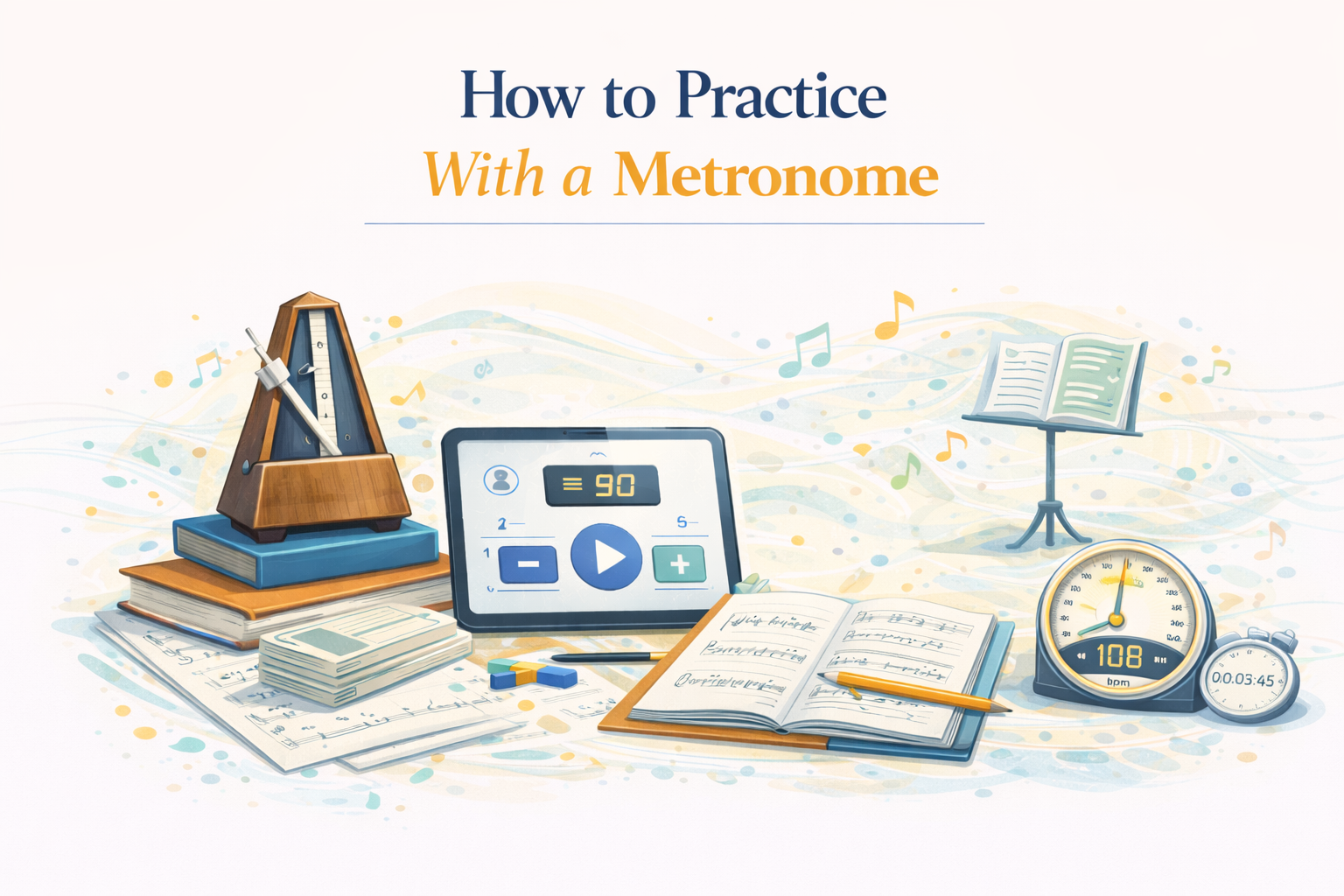How to Practice With a Metronome
Learning how to practice with a metronome is one of the most effective practice techniques you can develop. When you practice with a metronome, you build a stronger internal sense of time and a more reliable internal pulse.
That internal pulse is what allows you to play in time with other musicians, stay steady during long notes, and feel confident performing without a metronome. Whether you’re working on a new piece of music or refining something you’ve played for years, practicing with the metronome helps remove guesswork and replaces it with consistency.
How to Use a Metronome to Practice
This is a simple, repeatable approach to practicing with the metronome that works at all levels.
- Isolate the difficult passages. Limit yourself to no more than 20 measures at a time, and sometimes as little as one measure.
- Set the tempo where you can play the passage perfectly. This is your comfortable tempo, and it is often much slower than you want.
- Once you have played the passage three times in a row with no missed notes, increase the metronome by 4 beats per minute.
- Repeat the process. If you can’t play it cleanly, slow the tempo back down by 2 BPM.
- Continue to bump up the tempo gradually until you reach performance speed.
- Turn the metronome off.
- Play through the passage without a metronome.
- Turn the metronome back on and compare.
Always write down the tempo you finish at in your practice journal or lightly in pencil on the music. This tells you exactly where to start in your next practice session.
This approach ensures you are actually able to play the passage, not just hoping it works at fast speeds.
Setting the Metronome the Right Way
Setting the metronome correctly matters just as much as using it consistently.
First, decide which note gets the beat. In most cases, this will be the quarter note. If the tempo marking says 120bpm, that usually means 120 beats per minute on the quarter note.
When setting the metronome, make sure you understand the time signature and where beat one, or the downbeat, falls. Feeling beat one clearly will help you avoid rushing entrances or dragging long notes.
A good habit is to place the metronome on your music stand so the click is present but not overwhelming.
Using Subdivisions During Practice
Many musicians struggle at slow tempos because the metronome click feels too far apart. This is where subdivisions help.
Most metronomes allow you to subdivide the beat so you hear every eighth note or even every quarter note subdivision. For example:
- If the passage has sixteenth notes, subdivide into eighth notes or sixteenth notes.
- If the tempo is slow, hearing every beat helps you internalize the space between clicks.
Subdividing is especially useful when working on arpeggios, changing chords, or rhythmically complex passages. It also improves your ear for music and your ability to feel different tempos accurately.
Different Ways to Use a Metronome
There are many ways to use a metronome beyond clicking on every beat.
Try experimenting with:
- Clicking only on beats 2 and 4
- Clicking only on beats 1 and 3
- Clicking once every other measure
- Clicking on every quarter note, then removing clicks gradually
These approaches help develop a great sense of time and force you to internalize the tempo instead of leaning on the metronome.
Turn the Metronome Off at the Right Time
The goal of practicing with the metronome is not dependency. The goal is confident playing.
Once you feel steady, try this process:
- Start with the metronome.
- Listen to the tempo until you can clearly feel what the tempo sounds like.
- Turn it off.
- Play the passage while maintaining the internal beat.
- Turn the metronome back on to check yourself.
If your tempo drifts, repeat the process at a slower tempo. Over time, you’ll be able to play more accurately without external help.
Using an Online Metronome for Daily Practice
An online metronome is especially helpful for daily practice because it’s always available and easy to adjust. You can quickly set the tempo, change subdivisions, and increase the metronome without breaking your focus.
Using your metronome consistently, even for just a few minutes each practice session, adds up over years of playing.
Advanced Metronome Practice Ideas
Once you’re comfortable, try these variations:
- Start slow, then go faster until the tempo breaks down
- Practice improvising while keeping a steady tempo
- Record yourself playing with and without the metronome
- Practice long notes while locking into every beat
- Practice fast passages at slow tempos with perfect control
The metronome will help you diagnose problems you didn’t realize were there.
Final Thoughts on Practicing With a Metronome
A metronome is one of the most powerful tools in music school and beyond. When used effectively, it trains consistency, improves musicianship, and strengthens your internal sense of time.
If you put in the practice time and use the metronome intentionally, you’ll be able to play more confidently, more musically, and more reliably... with or without the click.
